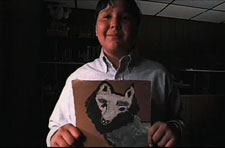Format
 will have a strong visual point of view. It will be filmed in professional, broadcast-quality video using the DV Cam format. This format provides portability, exquisite visual and sound quality, discreet presence and adaptability.
will have a strong visual point of view. It will be filmed in professional, broadcast-quality video using the DV Cam format. This format provides portability, exquisite visual and sound quality, discreet presence and adaptability.  will not look or feel like a typical video documentary or news magazine piece. To enhance the overall esthetic of the film, the footage will be transferred to film, color corrected and then digitally mastered back to tape for broadcast. This process will help unify the collection of scenes shot in different environments that comprise the final film, while lending credibility and beauty to the piece.
will not look or feel like a typical video documentary or news magazine piece. To enhance the overall esthetic of the film, the footage will be transferred to film, color corrected and then digitally mastered back to tape for broadcast. This process will help unify the collection of scenes shot in different environments that comprise the final film, while lending credibility and beauty to the piece.
The core of the stories will be told using a cinema verite' style to capture diary entries and intimate scenes of daily life (from ordinary conversations to conflicts) and to gain a first-hand perspective of the unpredictable events that tend to go hand-in-hand with this disease.
 Enriching the verite’ footage, we will shoot portraits of our subjects, images of their art work and personal items—family photos, medical records, favorite toys or mementos—the physical elements that make up their life stories. This B-roll “scrapbook” of information will include images both gathered from, and recreated on, different mediums such as still photography, slides, 16 millimeter and Super 8 film. The collective effect will establish an understanding of the characters as not just case studies, but living, breathing human beings.
Enriching the verite’ footage, we will shoot portraits of our subjects, images of their art work and personal items—family photos, medical records, favorite toys or mementos—the physical elements that make up their life stories. This B-roll “scrapbook” of information will include images both gathered from, and recreated on, different mediums such as still photography, slides, 16 millimeter and Super 8 film. The collective effect will establish an understanding of the characters as not just case studies, but living, breathing human beings.
Interviews and information provided by various experts will lend support and a greater understanding of the problems behind the stories. More than a laundry list of scientific facts delivered by talking heads, these segments will pull viewers beyond the  scientific veneer and engage their imaginations and emotions by utilizing imaginative settings appropriate for the subject’s area of expertise. For example, a medical researcher discussing the cerebral deformations caused by FAS might be interviewed standing between oversized MRI slides, clearly illustrating healthy and deformed brain tissue. Other interviews may incorporate visual metaphors to explain various facets or consequences of the condition with simple, striking clarity. For example, illustrating basic cognitive difficulties could be accomplished with a time-lapse sequence, shot from an overhead perspective, of a child attempting to build a wooden puzzle. Captured over the course of an hour or two and played back in a few seconds, the sequence would resemble a blur of disjointed and incomplete activity.
scientific veneer and engage their imaginations and emotions by utilizing imaginative settings appropriate for the subject’s area of expertise. For example, a medical researcher discussing the cerebral deformations caused by FAS might be interviewed standing between oversized MRI slides, clearly illustrating healthy and deformed brain tissue. Other interviews may incorporate visual metaphors to explain various facets or consequences of the condition with simple, striking clarity. For example, illustrating basic cognitive difficulties could be accomplished with a time-lapse sequence, shot from an overhead perspective, of a child attempting to build a wooden puzzle. Captured over the course of an hour or two and played back in a few seconds, the sequence would resemble a blur of disjointed and incomplete activity.
The combined effect of the stories told through the diary, verite’, B-roll and supporting footage will involve viewers on an emotional level with the characters while clearly communicating with creativity and poignancy the day-to-day reality of living with this disability.
 In exploring the issue through the eyes and words of those living with it,
In exploring the issue through the eyes and words of those living with it,  accepts the fact that FAS is a reality in our society and presents three compelling stories of people struggling with it.
accepts the fact that FAS is a reality in our society and presents three compelling stories of people struggling with it.
Through these stories,  is dedicated to promoting awareness and possible prevention of FAS and promoting hope by exploring the innovation, creativity, and success of various non-invasive therapies.
is dedicated to promoting awareness and possible prevention of FAS and promoting hope by exploring the innovation, creativity, and success of various non-invasive therapies.